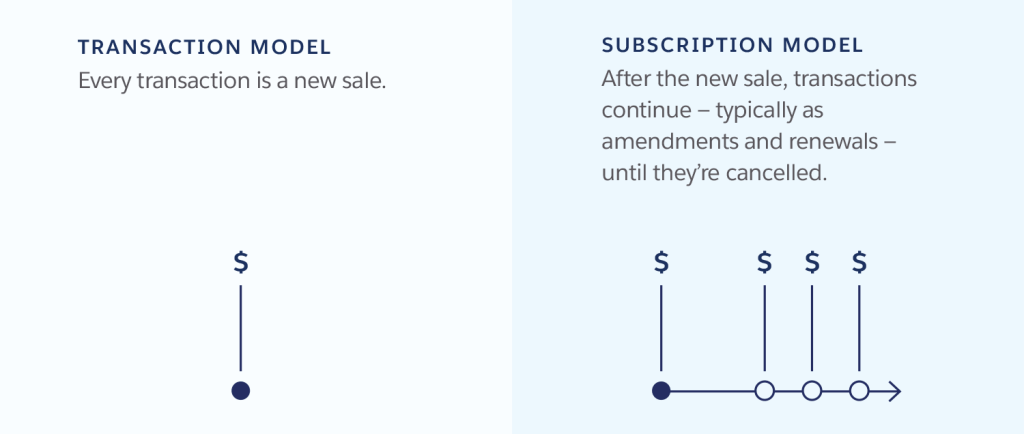It’s strategic if you think about it — when business-to-business (B2B) companies focus less on getting new customers and more on retaining the customers they already have. That’s what subscription business models are all about: nurturing customer relationships over time and enjoying the growth that follows as customers continue to renew.
That’s the vision anyway. The truth is subscription business models don’t always succeed. They succeed and fail depending on whether customers stay or leave. If your customers don’t get the value you promised them, they’ll leave, and your growth will stall.
So the task before you is to become more customer-centric than ever. How? By delivering more seamless interactions to your customers across the entire buying and paying journey — driving customer retention and, as a result, recurring revenue growth.
Here are some tips to put subscriptions to work for your business.
What is a subscription business revenue model?
Subscription business models are when customers pay regularly for ongoing access to a product or service. Think Netflix, Amazon Prime, or Salesforce. Subscription business models can speed up growth because they create recurring revenue, or revenue that occurs again and again over predictable intervals (like every month or year) when customers renew their subscriptions.
What are the benefits of subscription and usage revenue models?
Subscription business models can help businesses navigate economic uncertainty. They create a stable base of returning customers and generate predictable revenue that you can plan for longer into the future. Here are the benefits in more detail:
Accelerated revenue. As your company attracts more subscribers, recurring revenue increases exponentially.
Predictable revenue. Stop hitting the revenue reset button every quarter. Companies with subscriptions will often start each quarter with a baseline revenue at or near the previous quarter (depending on churn), then build on top of that.
Business agility. Establishing long-term customer relationships creates valuable ongoing data that you can use to better understand and serve your customers. You can learn from customer behaviour — using platforms like Customer 360 where you can manage all customer data in one place — and respond with new offerings that match. The more you do this, the more efficient product launches will be.
In essence, subscriptions and usage add another dimension to revenue. As shown in the illustration below, revenue from one-time sales goes from a point (a single transaction) to a line of many points (subscriptions).

What are the different kinds of subscription revenue models?
There are many different kinds of subscription revenue models, but what they all represent is a common shift — you’re charging for the access to products rather than products themselves. Here are the three most important models:
- Pure subscription model: Revenue is fixed for each subscription period. The amount that gets paid — and when — is predetermined. For example: a flat-rate monthly subscription fee for Spotify.
- Pure usage, also known as a consumption model: Here, revenue is variable. The amount that gets paid — and when — is determined by use. For example: ride-hailing services like Gojek or online food ordering platfoms like foodpanda.
- Hybrid model: In this scenario, customers are served a combination of subscription and usage options so revenue has both fixed and variable elements. For example: excess fees for additional data usage on top of a flat-rate monthly bill for mobile plans.
How can I implement a subscription model in my business?
To implement a subscription model, bring in tools and processes that help you build a consistent buying journey. Then, track new metrics to make sure you’re on the right path.
Here are the steps to get there:
1. Give customers the power to buy and pay over any channel
With subscription selling, you’re interacting with your customers constantly, and they don’t always want to pick up the phone. Increasingly, they want to engage with you on their own terms anytime and anywhere.In the wake of the pandemic, self-service such as chatbots and account portals have become more popular. There is an increase in the customers’ use of self-service portals from 59% in 2020 to 65% in 2022.
As such, providing omnichannel engagement is essential. Customers turn to an average of nine different channels to communicate with companies, and 78% of customers have used multiple channels to start and complete a transaction. To meet this shift in customer expectations, you need to make it possible for customers to renew, upgrade, and pay instantly on the channels they prefer. That could mean setting up a website or a mobile app, for instance.
With the proliferation of digital channels, 90% of business buyers and 84% of consumers expect consistent experiences across touchpoints. How can you create a smooth and consistent customer journey as they cross channels — for example, starting a purchase online, but then being routed to a representative when they hesitate at checkout? Subscription management can help. It combines customer relationship management (CRM) tools with the power of self-service to give every team access to the same data, so you can always pick up customer conversations where they left off.
2. Focus on customer value
Subscriptions are all about delivering value to your customers. You’re regularly asking them to renew and pay. If the value isn’t there, customer retention won’t be there either — they’ll leave and your growth will slow down.
Shift your thinking from shipping products to shipping value. How can you continuously deliver value-as-a-service to your customers? For example, Netflix doesn’t ship DVDs. They deliver entertainment-as-a-service. Amazon’s value isn’t in shipping products (although they’re very good at it). It’s in delivering exceptional buying experiences-as-a-service.
Value comes into play as customers access and use the product. This puts the spotlight on two teams — service and customer success — who will need to work together to make sure adoption and satisfaction are high.
A CRM that provides data transparency and automation is key here. With complete visibility into every customer, at every stage, you can help your customer solve a problem early before it becomes a frustration.
Automation can help speed up the customer service process, reduce support agent errors, and most importantly cut costs. With the help of AI, your service team can recommend customers the products that best suit their needs or help them solve their account issues in no time. Enabling automated workflows allows teams to do more with less.
3. Track recurring revenue with new metrics
Customer retention and customer value — which lead to recurring revenue — are the star metrics now. However, you can’t grow customer retention if you don’t have a way to measure it.
First, let’s take a look at customer value metrics. You can measure customer value by monitoring how much your customers are adopting your subscription product or service. An important metric to track is average revenue per user (ARPU), which is calculated by dividing your revenue by your users. As your business matures and you become more effective at targeting customers with the right offerings (while also getting them to stay and renew), you should see your ARPU increase.
To measure top-line revenue growth, track monthly recurring revenue (MRR) and annual recurring revenue (ARR).These are prized because increasing them means your revenue becomes more predictable and you’re able to plan ahead longer-term.
Ready to open new paths to revenue growth?
A subscription business can only succeed through authenticity. There’s no faking it. Customers only renew when they experience real, ongoing value for their money. That’s the challenge and the opportunity. Get close to your customers, know them, and give them what they want and how they want it. In the end, the value will go both ways — and you’ll have the resilient revenue stream to show for it.
Learn how to connect with your customers and speed up revenue growth in a digital future.
DOWNLOAD GUIDE
This post originally appeared on the U.S.-version of the Salesforce blog.

























